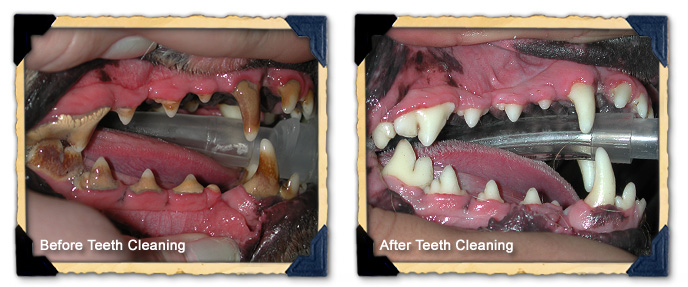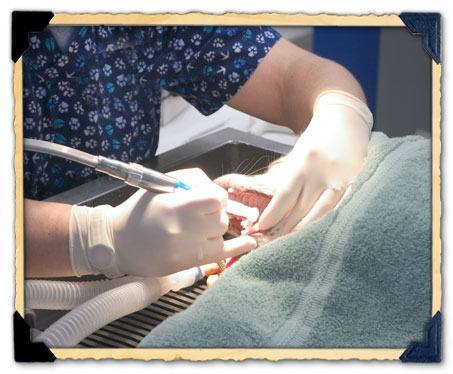North Haven/Wallingford Pet Dental Services
Dental Signs • Your Pet's Dental Cleaning • Pre-Dental Workup • Home Dental Care • Complete Dental Care
Signs of Pet Dental Problems
You are a responsible pet owner. You take good care of your pet. But do you always remember to take care of your pet's teeth?
Pets have dental diseases and problems just like people do. Many of these problems can be avoided by bringing your pet to either of our hospitals for regular dental check-ups and dental cleanings. In between visits to the veterinarian, check your pet's teeth regularly for signs of problems. Symptoms of dental disease include:

- Bad breath
- A yellowish-brown crust of plaque on teeth near gum line
- Red, swollen gums
- Pain or bleeding when your pet eats or when mouth is touched
- Decreased appetite or difficulty eating
- Loose or missing teeth
Does your pet have bad breath or reddened gums? If so, gingivitis could be the cause. If left untreated, gingivitis can lead to an infection called periodontal disease.
Your Pet's Dental Cleanings
Dentistry for your pet is quite different from human dentistry. For most of us, caring for our teeth and gums has been part of our daily routine for as long as we can remember. Consequently, a person's visit to the dentist is relatively brief and does not require sedation. In contrast, your pet's dental care is considerably more involved, time consuming and complex. It requires general anesthesia and, consequently, a day's hospitalization and the skills of several people, from veterinarians to veterinary technicians and assistants.
 Pre-Dental Workup
Pre-Dental Workup
A pre-dental workup involves laboratory and diagnostic tests to better evaluate your pet's current health status and to assure an appropriate anesthesia protocol. Current medical problems must be evaluated and any possible unknown problems must be identified prior to dentistry.
For all pets, regardless of age, we suggest bloodwork be performed either a few days prior or the day of their dental procedure. For older animals, blood work is required prior to the procedure.
Your pet's dental cleaning begins with a physical examination. This is important to evaluate your pet's general health. After the physical exam, your pet is given anesthesia for a safe and painless sleep during the dental cleaning.
The second part is the removal of tartar. This is done by hand. Next, an ultrasonic scaler is used above and below the gum line. Once the teeth have been thoroughly cleaned, a periodontal probe is used to check for pockets. Deep pockets could mean periodontal disease and infection. If necessary, dental radiographs are taken to help guide further treatment. Your pet's teeth are then polished, creating a smooth surface. Finally, the gums are washed with an anti-bacterial solution to help delay tartar build-up both below the gum line and on the crown of the tooth.
Home Care & Prevention
Dental care does not end with a visit to our hospital. You need to continue your veterinarian's good work at home. Brushing your pet's teeth is an important part of home dental care. One of our staff members will show you the proper method of brushing your pet's teeth.
Give Your Pet Complete Dental Care
Annual exams and home dental care help keep your pet's breath fresh and gums and teeth healthy. Your pet's smile and healthier life will be matched by your smile and pride in a job well done.